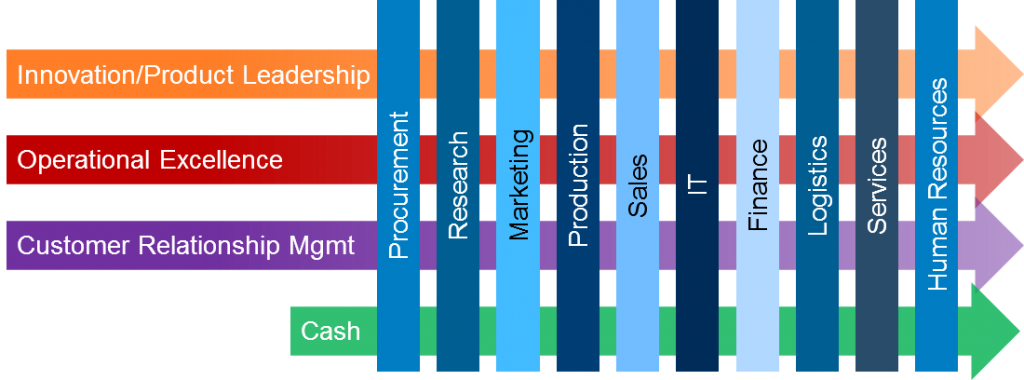Sales and Operations Planning (S&OP) started out with big aspirations. As initially conceived, S&OP was to cover the entire domain now called Integrated Business Planning (IBP). As S&OP process implementations rolled out during the 1980’s, this broad scope turned out to be a bit much to attempt in one bite. S&OP instead settled effectively into a more focused and limited role, and it would be another decade before a new attempt, and a new name, IBP, re-emerged to tackle the larger picture.
So what is the difference between the two, and does it matter?
Briefly, S&OP is the balancing act between supply and demand. It sets the production plan for the upcoming period based on the unconstrained sales/demand forecast but informed and adjusted for other supply chain constraints such as capacity, material supply, inventory levels, logistics, and customer lead-time requirements.
S&OP is a process focused on the EFFICIENCY of the production process. In terms of Treacy and Wiersema’s three Value Disciplines, S&OP is concerned with the efficiency and effectiveness of the horizontal OPERATIONAL EXCELLENCE value discipline. Note that while the prescription of the Value Disciplines is that organizations should focus on achieving excellence in primarily only one of the three, all three are always present, so even if your chosen value discipline is Customer Intimacy or Innovation, you still have an operational aspect to your business that needs to be optimized.
What does IBP bring to the party that S&OP lacks? Alignment. Financial and strategic alignment.
A couple of years ago I wrote this post (“The Nine-Foot Aviator”) about what first steps to take when attempting to institute an IBP process. I had to admit then that, despite the brilliant description of east-west versus north-south processes by Gartner’s Noha Tohamy, I and much of the audience that heard her presentation still seemed confused over definitions and boundaries and roles and functions when it came to differentiating S&OP from IBP. It was all a bit fuzzy, although you could see hints of the resolution in the IBP calendar shared at the IE Group conference by Verso Paper’s Michael Partridge – review sessions that included finance, risk and general management in addition to the usual production, demand and supply suspects.
However, if you approach the two processes from the perspective of the Value Disciplines, the distinction becomes obvious (see "The Sound and the Fury" for the connection between the value disciplines and your value-creation business processes). As I mentioned above, S&OP operates primarily within the horizontal, east-west, operational discipline, with the aim of improving the efficiency and effectiveness of that discipline. IBP, however, takes a broader, north-south perspective – the ALIGNMENT of S&OP and the Operational Excellence discipline with the organization’s financial and strategic objectives. What is optimal for the horizontal production and supply chain process might not be optimal for the business as a whole. Examples include:
- Does the S&OP plan meet cash flow, earnings, revenue and margin objectives?
- Does it meet the company’s risk appetite / profile, and are the identified risk mitigation plans acceptable?
- Does it comply with safety and sustainability requirements?
- Does it appropriately support marketing, new product/territory expansion and commercial initiatives?
- Does it align with other strategic objectives, such as quality or customer retention?
In other words, IBP does two things that S&OP does not:
- It aligns one value discipline, operations, with the other two – innovation and customer relationship management.
- It aligns the Operational Excellence value discipline with the broader, high-level strategic objectives of the organization as a whole.
In order to fulfill the promise of IBP, the key takeaway from this would be to move beyond just the alignment of S&OP and Operations and generalize the intent and scope of IBP to include all three value disciplines. In most companies the product development and customer relationship value disciplines have their own internal efficiency and effectiveness processes , maybe not as complex as S&OP but every bit as critical, especially if one of them is the organization’s chosen strategic focus. It should not be sacrilegious to expect for R&D to regularly check its alignment with the company’s marketing direction or customer service performance, nor for marketing to likewise understand product development roadmaps and for sales to proactively be aware of the ever changing array of production and development constraints that could impact client relations.
IBP as a concept has wider applications than just policing S&OP, and you can use the process as applied broadly to manage your business holistically, complementing horizontal business-process efficiency with vertical and strategic alignment. Via S&OP, East has already met West – with IBP, East gets introduced to North and South as well.



1 Comment
Pingback: East meets North: Integrated Business Planning for both efficiency and alignment | EPM Channel